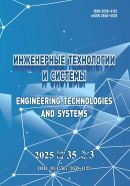UDK 664.723:62-5
DOI: 10.15507/0236-2910.026.201601.032-039
ON THE QUESTION OF PROCESS CONTROL COMBINED GRAIN DRYING
Valentina Afonkina (senior lecturer of Electrical Engineering and Automation chair, Institute of Agricultural Engineers, South Ural State Agricultural University (75, Lenin Prospekt, Chelyabinsk, Russia), ORCID: http://orcid.org/0000-0001-9743-5278, This email address is being protected from spambots. You need JavaScript enabled to view it.)
Viktor Zakhakhatnov (associate professor of Electrical Engineering and Automation chair, Institute of Agricultural Engineers, South Ural State Agricultural University (75, Lenin Prospekt, Chelyabinsk, Russia), Ph.D. (Engineering), ORCID: http://orcid.org/0000-0002-2856-9755, This email address is being protected from spambots. You need JavaScript enabled to view it.)
Vladimir Mayerov (professor of Administrative and Financial Law, Institute of State and Law, Tyumen State University (6, Volodarskiy Str., Tyumen, Russia), ORCID: http://orcid.org/0000-0002-6490-3546, This email address is being protected from spambots. You need JavaScript enabled to view it.)
Vitaliy Popov (professor of Electrical Engineering and Automation chair, Institute of Agricultural Engineers, South Ural State Agricultural University (75, Lenin Prospekt, Chelyabinsk, Russia), Dr.Sci. (Engineering), ORCID: http://orcid.org/0000-0001-5773-4839, This email address is being protected from spambots. You need JavaScript enabled to view it.)
A large part of the grain produced in the South Urals has high humidity and needs to be dried before storage. Drying is an energy-intensive process and is about 70 % of the total energy consumption for post-harvest processing of grain. Modern grain drying equipment, implements high-convection drying, and heat provides cost 5 350–5 500 kJ per 1 kg of evaporated moisture, which is well above the theoretical calculations. Combined drying, which involves high-temperature drying step and aeration enables to reduce heat costs up to 30 %. To control the combined drying process it is necessary that final grain moisture relates to such parameters of high-temperature drying and aeration as the initial moisture content, the temperature of grain and the time subsequent aering. The paper describes the said relation as a mathematical model of the second order obtained experimentally for wheat. The model has been derived from the implementation of Box-Benkin plan for three factors – the initial grain moisture, temperature and time of grain heating and aering. The experiment was conducted for a 200 mm thick fixed grain bed. We also have got a model relating energy consumption to the said parameters. The model of the final grain moisture within the variation of factors can be used to create a control algorithm for combined drying. Taking as the set parameters final moisture, initial moisture and grain heating temperature, a microcontroller calculates the time for active aering necessary to obtain final grain moisture and an unloading mechanism provides the necessary time through regulating the discharge rate. The model makes it possible to calculate the energy usage for drying at different values of initial moisture, temperature and time of grain heating and aering.
Keywords: combined drying, moisture content, experiment, model, management
For citation: Afonkina VA, Zakhakhatnov VG, Mayerov VI, Popov VM. On the question of process control combined grain drying. Vestnik Mordovskogo universiteta = Mordovia University Bulletin. 2016; 1(26):32-39. doi: 10.15507/0236-2910.026.201601.032-039

This work is licensed under a Creative Commons Attribution 4.0 License.

















